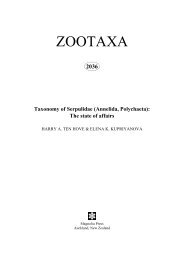Create successful ePaper yourself
Turn your PDF publications into a flip-book with our unique Google optimized e-Paper software.
acts and are referred to the ulei morphotype.<br />
In northwestern Peru (Amazonas) and just reaching extreme southern Ecuador (Zamora-Chinchipe),<br />
specimens are large with ovate pinnae, densely spiny peduncular bracts, and large fruits. They are referred to<br />
as the amazonas morphotype.<br />
In central Peru (San Martín) specimens are extremely variable. A single specimen from southern San<br />
Martín (Schunke 6927) is larger, with densely spiny sheaths and long, almost linear pinnae (sanmartin<br />
morphotype). A second specimen from the northern part of the department (Williams 6661) is completely<br />
different, with smaller, ovate pinnae and a finely spiny peduncular bract (ulei morphotype).<br />
In south-central Peru (Pasco) there are two specimens (Henderson 3009, Smith 3791) which are<br />
considerably larger than others and have large stems, long, lanceolate pinnae, and large inflorescences with<br />
densely spiny peduncular bracts (pasco morphotype). A specimen from Ucayali (Gentry 25466) is similar, but<br />
another from adjacent Junín (Macbride 5470) has more ovate pinnae and is referred to the large morphotype.<br />
In western Acre, Brazil, and adjacent Peru (Ucayali) specimens are of the large morphotype. One<br />
specimen (Henderson 1675) from western Acre on the border with Amazonas is of the ulei morphotype. Five<br />
specimens from eastern Acre (Coêlho 28, Daly 9387, 11986, Figueiredo 342, 615) resemble those of the ulei<br />
morphotype except for their pinnae with spinulose bases. They may represent hybrids with the sympatric D.<br />
mitis subsp. ecirratus.<br />
In Madre de Dios, Peru and western Bolivia specimens are all of ulei morphotype, although there is much<br />
variation in fruit size.<br />
Specimens from the Atlantic Coastal Forest of Brazil (polyacanthos morphotype) occur in two areas, with<br />
northern outliers in Ceará, Alagoas, and Pernambuco. There are too few specimens from there to test for<br />
differences between these areas. Along the Atlantic coast, D. polyacanthos occurs slightly more inland than<br />
the sympatric D. orthacanthos.<br />
20. Desmoncus prunifer Poepp. ex Martius (1823-1837: 148).<br />
Atitara prunifera (Poepp. ex Martius) Kuntze (1891: 727). Desmoncus polyacanthos var. prunifer (Martius) Henderson,<br />
1995: 233. Type:—PERU. Loreto: Maynas, Yurimaguas, December 1830, E. Poeppig 2148 (holotype G n.v.,<br />
holotype image!, isotypes GOET n.v., P!). Epitype (here designated):—PERU. Loreto: Yurimaguas, lower Río<br />
Huallaga, ca. 135 m, 22 August–9 September 1929, E. Killip & A. Smith 28045 (epitype US!).<br />
Plants height no data; stems 0.8(0.7–0.8) cm diameter, branching no data. Leaf petioles 3.8(2.2–5.4) cm long;<br />
rachises 46.5 cm long, 3.2(2.8–3.6) mm wide, the spines usually
















